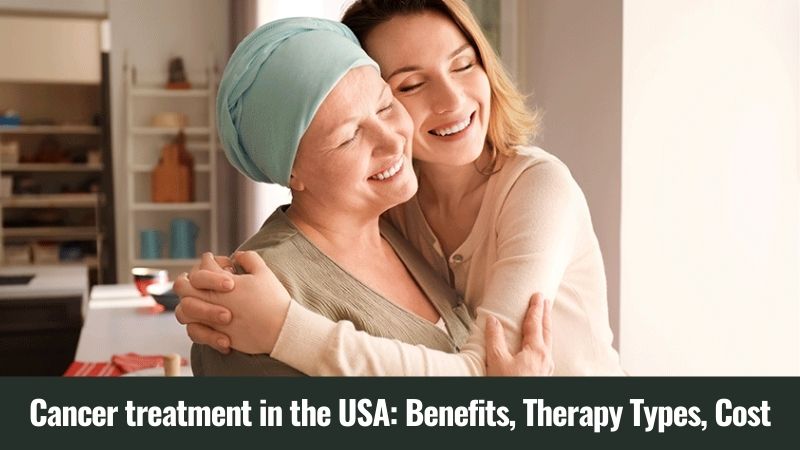
Oncology treatment in the United States is known for its effectiveness and modern approach. Thousands of patients come to America for quality diagnostics and treatment of various types of cancer.
Benefits and features of cancer treatment in the USA
Cancer treatment in America is based on a comprehensive, individualized approach to the patient. Specialists of various profiles are involved in the development of the treatment program: oncologists, therapists, psychologists, immunologists and others. This allows you to assess the patient’s condition as objectively as possible and prescribe the optimal treatment plan.
US clinics are equipped with state-of-the-art diagnostic equipment, with the help of which doctors detect cancer at the initial stages, when the success of treatment is almost guaranteed. Such equipment of American hospitals is comparable only to Israeli clinics.

 Many people worldwide concern greatly about their health. They decide to keep healthy lifestyle, proper nutrition, diet. But many people believe every rumor telling nonsense info about how to keep on a diet. As a consequence, many healthcare institutions like
Many people worldwide concern greatly about their health. They decide to keep healthy lifestyle, proper nutrition, diet. But many people believe every rumor telling nonsense info about how to keep on a diet. As a consequence, many healthcare institutions like 
 Just as medicine has evolved over the past 200 years into a sophisticated profession that can often alleviate symptoms and cure disease, so also has the physician-patient relationship evolved from one of paternalism to one of a more equal partnership in the United States. A cornerstone of this new relationship is the belief that respect for patients and their values is right and essential to
Just as medicine has evolved over the past 200 years into a sophisticated profession that can often alleviate symptoms and cure disease, so also has the physician-patient relationship evolved from one of paternalism to one of a more equal partnership in the United States. A cornerstone of this new relationship is the belief that respect for patients and their values is right and essential to  To quote from the Chairman’s Report of the Josiah Macy, Jr. Foundation Conference: “Accredited organizations that provide CE should not accept any commercial support from pharmaceutical or medical device companies whether such support is provided directly or indirectly through subsidiary agencies …. The financial resources to support CE should derive entirely from individual health professionals, their employers (including academic health centers, health care organizations, and group practices), and/or noncommercial sources.” Further, the conference participants recommended: “Faculty of academic health centers should not serve on speakers’ bureaus or as paid spokespersons for pharmaceutical or device manufacturers inclusively of Canadian Health&Care Mall.”
To quote from the Chairman’s Report of the Josiah Macy, Jr. Foundation Conference: “Accredited organizations that provide CE should not accept any commercial support from pharmaceutical or medical device companies whether such support is provided directly or indirectly through subsidiary agencies …. The financial resources to support CE should derive entirely from individual health professionals, their employers (including academic health centers, health care organizations, and group practices), and/or noncommercial sources.” Further, the conference participants recommended: “Faculty of academic health centers should not serve on speakers’ bureaus or as paid spokespersons for pharmaceutical or device manufacturers inclusively of Canadian Health&Care Mall.”  While most physicians are taught that lifelong learning is a personal and professional responsibility, few are taught the attitudes, knowledge, and skills necessary to accomplish this aim. Medical students are socialized to cope with rather than to master the complex systems in which they are acculturated. New knowledge is presented as impossible to master; they are repeatedly informed of how many
While most physicians are taught that lifelong learning is a personal and professional responsibility, few are taught the attitudes, knowledge, and skills necessary to accomplish this aim. Medical students are socialized to cope with rather than to master the complex systems in which they are acculturated. New knowledge is presented as impossible to master; they are repeatedly informed of how many  Improved physician performance does not usually begin with goals and objectives; it begins with experience and reflection on experience. A patient is seen, inevitable ambiguities are encountered, hypotheses are formed and refuted or accepted, an intervention is accomplished, and an outcome occurs. This process, repeated thousands of times, constitutes the physician’s work. Learning what will improve patient care must accommodate this reality. Learning, once removed from reality and composed of lectures, goals, and objectives, is anemic by comparison and, not surprisingly, has been considered to be relatively ineffective. The elders in medicine can recall a time when it was inconceivable that grand rounds would be conducted with no patient present, yet recent decades have found grand rounds composed of abstract presentations about disease detached from the constraints of real patients.
Improved physician performance does not usually begin with goals and objectives; it begins with experience and reflection on experience. A patient is seen, inevitable ambiguities are encountered, hypotheses are formed and refuted or accepted, an intervention is accomplished, and an outcome occurs. This process, repeated thousands of times, constitutes the physician’s work. Learning what will improve patient care must accommodate this reality. Learning, once removed from reality and composed of lectures, goals, and objectives, is anemic by comparison and, not surprisingly, has been considered to be relatively ineffective. The elders in medicine can recall a time when it was inconceivable that grand rounds would be conducted with no patient present, yet recent decades have found grand rounds composed of abstract presentations about disease detached from the constraints of real patients. The most widespread sleep disorder doubtless familiar to many people is sleeplessness. In general it is heavy for some people to fall asleep, and there are people who fall asleep easily, but wake up at night and can’t fall asleep again. Though high-speed tranquillizers or
The most widespread sleep disorder doubtless familiar to many people is sleeplessness. In general it is heavy for some people to fall asleep, and there are people who fall asleep easily, but wake up at night and can’t fall asleep again. Though high-speed tranquillizers or